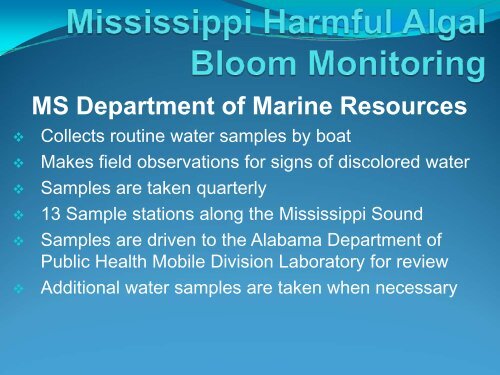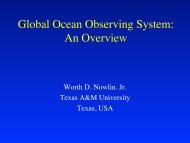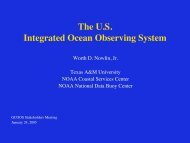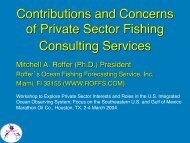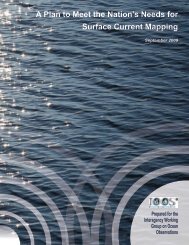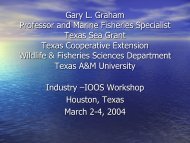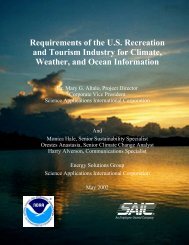MS Department of Marine Resources - Gulf of Mexico Coastal ...
MS Department of Marine Resources - Gulf of Mexico Coastal ...
MS Department of Marine Resources - Gulf of Mexico Coastal ...
Create successful ePaper yourself
Turn your PDF publications into a flip-book with our unique Google optimized e-Paper software.
<strong>MS</strong> <strong>Department</strong> <strong>of</strong> <strong>Marine</strong> <strong>Resources</strong><br />
Collects routine water samples by boat<br />
Makes field observations for signs <strong>of</strong> discolored water<br />
Samples are taken quarterly<br />
13 Sample stations along the Mississippi Sound<br />
Samples are driven to the Alabama <strong>Department</strong> <strong>of</strong><br />
Public Health Mobile Division Laboratory for review<br />
Additional water samples are taken when necessary
<strong>MS</strong> <strong>Department</strong> <strong>of</strong> <strong>Marine</strong> <strong>Resources</strong><br />
<br />
<br />
Volunteer for the Phytoplankton Monitoring Network<br />
An outreach program to monitor and maintain HAB<br />
events throughout the coast<br />
<br />
<br />
<br />
<br />
<br />
<br />
Provides qualitative data to scientists.<br />
To create a comprehensive list <strong>of</strong> harmful algal species inhabiting coastal marine waters<br />
To monitor and maintain an extended survey area along coastal waters throughout the year<br />
To isolate areas prone to harmful algal blooms (HABs) for further study by <strong>Marine</strong> Biotoxins<br />
researchers<br />
To identify general trends, such as time and area, where HABs are more likely to occur<br />
To create a working relationship with open communication between volunteers and researchers<br />
through PMN
Phytoplankton Monitoring Network<br />
<br />
<br />
Equipment includes: plankton net, sample bottles, salt<br />
refractometer, thermometer, Lugol’s solution<br />
Volunteer responsibilities include:<br />
Attend annual PMN training sessions<br />
Choose and regularly monitor a convenient sampling site<br />
Sample site weekly or bi‐weekly<br />
Perform preliminary identification <strong>of</strong> common species<br />
Preserve samples with any species in high abundance<br />
Submit data via online data entry (fax or email)
Current Mississippi PMN Volunteers<br />
<strong>MS</strong> Dept <strong>of</strong> <strong>Marine</strong> <strong>Resources</strong> – Shellfish Bureau<br />
<br />
<br />
Site: Pass Christian Oyster Reef<br />
Group Volunteers: Kristina Broussard, Steve Breland<br />
University <strong>of</strong> Southern Mississippi – <strong>Gulf</strong> Coast Research<br />
Lab and Center for Fisheries Research and Development,<br />
Ocean Springs, <strong>MS</strong><br />
<br />
<br />
Sites: GCRL Fishing Pier, St. Andrews Beach & Dog Key Pass<br />
Group Volunteers: Adrienne Flowers, Dawn Rebarchik, Dr.<br />
Patrick Biber<br />
Independent Volunteer, Bay St. Louis, <strong>MS</strong><br />
<br />
<br />
Site: Washington Street Pier<br />
Group Volunteer: Kay Ward‐Lange
Needs<br />
• More Public Education within the State<br />
• Better Coordination with Monitoring between<br />
Research Activities and State Managers<br />
• Increase Communication within the <strong>Gulf</strong> States


